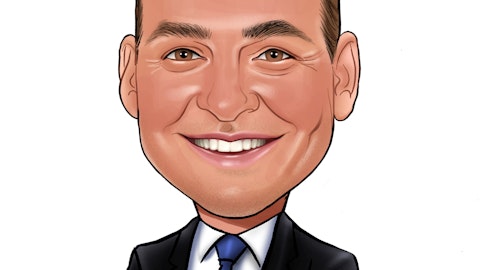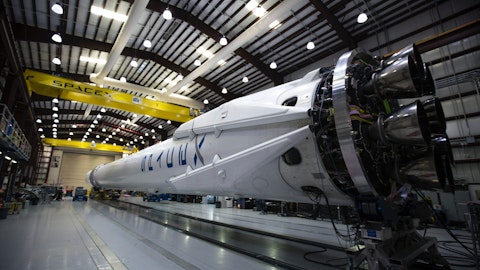Astronics Corporation (NASDAQ:ATRO) Q4 2022 Earnings Call Transcript March 2, 2023
Operator: Greetings. Welcome to the Astronics Corporation Fourth Quarter Fiscal Year 2022 Financial Results. At this time, all participants are in a listen-only mode. A question-and-answer session will follow the formal presentation. Please note this conference is being recorded. I will now turn the conference over to your host, Craig Mychajluk, Investor Relations. You may begin.
Craig Mychajluk: Yes, thank you and good afternoon everyone. We certainly appreciate your time today and your interest in Astronics. On the call here with me are Pete Gundermann, our Chairman, President and Chief Executive Officer; and Dave Burney, our Chief Financial Officer. You should have a copy of our fourth quarter and full year 2022 financial results, which we released just after the market closed today. If you do not have the release, you can find it on our website, astronics.com. As you are aware, we may make some forward-looking statements during the formal discussion and the Q&A session of this conference call. These statements apply to future events that are subject to risks and uncertainties as well as other factors that could cause actual results to differ materially from what is stated here today.
These risks and uncertainties and other factors are provided in the release and with other documents filed with the Securities and Exchange Commission. You can find those documents on our website or at sec.gov. During today’s call, we will also discuss some non-GAAP financial measures. We believe these will be useful in evaluating our performance. You should not consider the presentation of this additional information in isolation or as a substitute for results prepared in accordance with GAAP. We have provided reconciliations of non-GAAP measures with comparable GAAP measures in the tables that accompany today’s release. With that, let me turn it over to Pete to begin. Pete?
Pete Gundermann: Thanks, Craig, and good afternoon everybody. Thanks for tuning in for our fourth quarter conference call. As usual, or as is often the case, I’ve tried to simplify the headlines for the quarter and the things that I would broadly categorize as good news, things that I think will be well received by our investor base and some other things that are less good, maybe bad challenges that we want to also give equal time to. And we will kind of close with a turning our attention away from 2022 and turning towards 2023 and talking about what we expect to happen in the current year and how we think it’s going to play out, recognizing that it’s pretty early and a lot can happen. So the good news headlines strong demand continues as evidenced by our bookings, $182 million in bookings is a very solid performance, our second highest since COVID came in, and a very good close for the year.
We’ll talk in detail about bookings and how that’s translated into a record backlog and how that sets us up for a solid opening frame for 2023. We’ll also talk about some reasons why we think that strong bookings level is very likely to continue based on how our market is evolving and how some of our programs are playing out. Second positive good news headline is that the revenue ramp that we’ve been looking for we believe has begun. We have since COVID struck been stuck in a quarterly revenue band of about $105 million to $130 million and just seemed to have a really hard time getting beyond that level until the fourth quarter, $159 million, frankly, was higher than we thought we would be. As we started the quarter, we think it’s a positive indicator again as we head into 2023 and it gives us more confidence that our supply chain is pulling out of the real funk that it was in for most of the second half of 2021 and the first half or two thirds of 2022.
Not to say it’s perfect, but we think it’s getting better, not getting worse. Third good news headline is that we got our refinance completed. That was technically a January event, not a fourth quarter event, but there was a lot happening behind the scenes in the fourth quarter to bring that about. And we want to talk that over in adequate detail when we get to it. If I flip over to the other side of the coin, kind of the bad news things that you might pick up on or might be concerned about, margins were under pressure primarily due to inflation that we’ve incurred and some special charges that we have paid to compensate for supply chain problems that was apparent if you look at our cost structure, our margins for the quarter, Dave will talk through that in some detail.
And also during the quarter, it became apparent that a couple of programs that we think overall long-term are going to be very positive. Contributors to our success are going to be delayed over what we thought they would be. I’m talking specifically about a major test program that we’ve talked about before for the Army of 4549/T call. It’s a radio test program. And fourth, good news, bad news, good news is that we’re on the Bell team and Bell was selected by Army for the U.S. Army for that program. Bad news is, as everybody probably knows, it’s under protest. And that means that we’re kind of at a standing stop, whereas we were hoping by now to be underway. We’ll turn our attention at the end to 2023 preview. We are maintaining earlier guidance of $640 million to $680 million.
That’s a big step up from 2022 we realize, but we believe we have some pretty solid reasons to think that that’s achievable. Supply chain, of course, will be critical and we’ll tell you what we know about our supply chain, but it’s early. We think that $640 million to $680 million range has upside potential and downside risk depending on how the supply chain performs as we get into the first half of 2023. So taking those topics in the range I just discussed, demand continues to be very strong. Fourth quarter bookings of $182 million, as I mentioned, second highest booking result since COVID only behind the previous quarter, the third quarter of 2022. Bookings for all of 2022 were $690 million. That’s a book-to-bill of 1.29 for the year and sets us up with a record backlog of $571 million as we began 2023.
You might be interested to know that our previous record backlog pre-COVID was $416 million in late 2018. That was a year when we did about $800 million in revenue. So $416 million was our previous high. Today we’re at $571 million or as we entered the first quarter we were at $571 million. It’s a big step up. Of that $571 million, $451 million is scheduled for delivery in 2023. Given the range we talked about for 2023 that leaves a couple hundred million of what we might call book and ship over the course of the year in the normal course that’s a pretty achievable number. That’s pretty low. Our supply chain gives us reason to be a little bit cautious about. It’s one thing to get the order, it’s another thing to turn on and ship it, but $200 million over the course of 12 months book and ship is pretty modest compared to what we’ve been used to.
We expect to see a strong demand continue for a couple of reasons. Our recovery so far has largely been based on the narrowbody regional market for the commercial transport industry. But now it appears widebody/long-haul is coming back pretty strongly. Pre-COVID, we were approximately 50-50 narrowbody, widebody. Widebodies have spent most of COVID parked in the desert. Narrowbodies are where the action has been as regional travel barriers have come down, but now with widebody coming back, we have reason to believe that we’re going to see another kind of source of strength from demand in the market, and we’re looking forward to that. You probably read the headlines. They’re all over the place. Airlines are pulling widebody airplanes out of storage and pressing them back in the service that not too long ago, most experts in the industry were predicting would never fly again.
A380s, A340s, even some 747s, but demand has come back strong enough that airlines are taking the expense of resurrecting these airplanes, and that’s good for us. Airplanes flying is good for us. Similarly, or also along the way production rates for the prominent widebody airplanes today specifically 787 at Boeing and A350, they’re talking about upward revisions to plans there. Now there are challenges, there are capacity issues to come across, but I guess my point is that as we look at what’s been driving our demand, it’s primarily been narrowbody. Now we think widebodies, and we’ve seen this happening over the last few quarters. We think widebodies going to be more and more of a contributor as we go forward. And that’s good for a company like us.
Also along these lines the opening up of China from travel restrictions is a very positive sign. Geographically, the recovery in the commercial airline industry has been driven by the U.S. and by Europe. Asia has lagged. China is not obviously a very popular location in Asia, it’s hard for the industry worldwide to recover without China recovering and China opening up two less strenuous travel restrictions as they did in early December, we think it’s going to have a very positive impact on our industry overall. The second issue I wanted to call attention to reason why we think demand is going to continue to be pretty strong is that while we have talked about a number of pretty major program wins over the last year, those program wins are not really reflected in our booking level today.
We think these programs collectively are going to be worth hundreds of millions of dollars. But today, if I were to add them up in backlog, they’re probably less than $20 million cumulative. And I’m talking about programs that we’ve announced Southwest win that we announced probably a year and a half ago now, and antenna program that we’re doing with Safran, the 4549/T program, some activity that we have going in the electric airplane market, and also FLRAA, I guess we haven’t talked as a conference call since the Bell decision came down. I think most people who follow our company know this, but we are on the Bell team. We’re doing the most of the electrical system right after generation to end use system. And it of course, assuming the protest doesn’t disrupt things, we expect this program will be a real significant program, hard to overstate its significance for our company over the long haul.
We’re under a little bit of a gag order. I can’t say much more than that. And we certainly don’t know what the inner workings are of the protests that’s going on currently, but that is one that we think is a major driver. And again, there are a couple other programs that we’re not at liberty to talk about that are similarly significant and all these we expect to start contributing to bookings and to demand in the coming quarters. But as of today or as of the end of the fourth quarter, I think it was less than $20 million, all of these things cumulatively. So I want to switch from bookings and demand to the revenue ramp as I mentioned, since COVID hit, we’ve really been stuck in a band of $105 million to $130 million in bookings or in excuse me, in quarterly revenue even though bookings have been much higher our quarter four revenue of $159 million is a significant step up towards where we need to be in 2023 to meet our goals and the satisfy customer demand.
The limiting factor through 2022 has been first supply chain and second people, much more of a supply chain issue than a people issue. And when all said and done, we’re going to look back on 2022 as a year of really strong demand and really disrupted supply chains where we had 20% growth and usually we would expect 20% growth to be caused for celebration. But frankly, we were aiming a lot higher when the year started. We saw the demand coming back. Our original plans for 2022 anticipated growth well beyond 20%. We ended up at 20% because we were constrained by supply chains. And while our supply chain is not perfect, as I mentioned earlier, we do feel it is improving. A year ago, we saw regular negative surprise disruptions coming across the line, today, there are more and more positive surprises and fewer and fewer negative surprises, hiccups still happen, but they’re fewer and we’re better at responding to them frankly, a year ago, we weren’t used to dealing with the level of detail and climbing down our supply chain to our supplier, suppliers as well as, as effectively as we can and do today.
So while the hiccups happen, they’re fewer and fewer and we’re better and better at responding to them. Our refi refinance, it was a complicated and drawn out process. We finally completed it on January 19 as most of you undoubtedly know. It’s a deal that we feel is adequate. Get us through the rest of the COVID recovery and frankly reflects the reality of our macroeconomic environment and the position that the company’s in at this point in the cycle. We need to perform, but if we can do what we think we can do, it should be an adequate facility for us for the time being. And Dave will cover some of those details in just a minute. The bad news headlines two of them I talked about margins under pressure. We had elevated input costs and those costs are going to take some time to sort out.

Photo by Daniel Klein on Unsplash
We have portions of our business where we can react pretty quickly. The order cycles are short. Frankly, a lot of the strong bookings that we’ve been taking are very helpful, because we’ve been able to work in pricing that reflects the current cost structure, it’s the longer term older contracts that in many cases tend to cause us problems. We also tend to run into troubles when supply chain has a hiccup and we have to make what we call spot buys or pay expedite fees. Those activities are getting fewer and fewer that are winding down and we expect them to continue to wind down, but they were a pretty major source of margin pressure or erosion in the fourth quarter. As we move through 2023, we expect that position to improve. A couple of program delays that I mentioned earlier, 4549/T, the Army radio test program.
As a reminder, we were identified or named back in August as the winner of a technical evaluation that the Army ran between a product we provided and a couple and those are the couple competitors. The next step at that point was to negotiate and develop a sole source production contract or a directed procurement. Going forward, we expected that directed procurement would be in place, probably by now, if not by the end of the year, it’s become apparent now that it’s going to be much later than that. We’re now thinking as we understand the Army’s processes that this could last until middle of the year or even a little bit later. Before we get under contract and before that program start seriously contributing. And depending on long lead funding and a couple of other things that are to be determined, it’s unclear at this point when that program’s going to contribute, but we believe that order will be somewhere in the neighborhood of $150 million to $200 million in revenue.
We expect that we’ll run over two to three years and we’re eager to get at it, but we just can’t get going until the Army wants us to. The other program that is stretching out because of the protest is the FLRAA program that I talked about earlier. We thought that we would be underway by now and now it appears that the protest period will last at least through April 6 or 7 I believe it is. And so we will not be under contract. We’re basically done in the water at this point. So that’ll be the second quarter start, we believe rather than a first quarter starts. With that amount of coverage, I think I’ll turn it over to Dave at this point. He’s got some Q4 specifics to talk through and also a summary of our refinance. Dave?
Dave Burney: Okay. Thanks, Pete. Following on to some of the points Pete made with regard to our sales and bookings, they continued to improve through the fourth quarter. The primary driver for both bookings and sales increase was the commercial transport market. Sales to this market were up 76% to about $103 million, which was an increase of a little over $44 million from last year’s fourth quarter, and up just over $24 million sequentially from the third quarter. Globally, air travel continues to improve driving demand for the aircraft retrofit spend and increasing OEM build rates. Now, there are a lot of puts and takes to compare last year’s P&L to this year’s, but the main driver was the increased margin on the sales ramp, partially offset by higher input costs and additionally, the 2021 fourth quarter had the benefit of $7.5 million from the AMGP grant program and the $5 million gain from the building that we sold in that quarter.
This was partially offset in that quarter by a full year’s accrual for our 401k cost. As we reinstated the company contribution in the fourth quarter of last year and higher legal fees. The 2022 fourth quarter, on the other hand, had the benefit of a $1.5 million gain relating to the litigation settlement. Contribution margin on incremental sales is running at about 40% right now. This is somewhat lower than our pre-pandemic contribution margins, which were typically closer to 45% to 50%. These are being impacted by input costs on labor and materials. The margins continue to face headwinds primarily from supply chain predictability, which impacts shop floor efficiency, as well as increased input costs that eventually will gradually be mitigated as we pass on these costs through new contracts.
It does appear that the trajectory of the inflation that we experienced through 2021 and early 2022 has slowed significantly. Additionally, we continue to source hard to find parts on the spot market, which is a significant impact to our margins. In the fourth quarter, these spot buys were roughly $2 million above our standard cost for these parts. We are expecting the impact of these spot buys to reduce as we move through this year. Switching to the balance sheet and cash flow for the company. Cash flow from operations for the fourth quarter improved and was a positive $10.8 million as our net loss improved as compared with the prior quarters this year. Networking capital remained flat with the third quarter and inventory growth was minimal during the quarter, which was a significant improvement over the last three quarters where inventory levels increased roughly $34 million during the first three quarters of 2022.
Increased receivables were offset by lower prepaid expenses and increased accounts payable. We are forecasting our inventory levels to drop as we move through the year as supply chain stabilizes and the shop floor becomes more efficient. CapEx for the quarter was $3.4 million, a little below our forecast. We’re forecasting CapEx for 2023 to be in the range of $17 million to $20 million, which is back in line with our typical spending levels after the last couple of years of cash conservation. At the end of the year, our net debt was $150.2 million, which is down from $156 million at the end of the third quarter. We’re forecasting to be cash flow positive for the year and the positive cash flow will be used to reduce debt. We’re expecting cash outflow relating to our 2022 taxes that will be paid in 2023 to be about $6 million during the year.
And this all relates to the new tax treatment for R&D costs where we’re now required to put them on the balance sheet and capitalize them in expense them over five years. To the credit facility update, on January 2019, we announced that we had closed on our new debt financing, which we had been working on for the better part of the year. The new financing structure replaces the cash flow based revolving credit facility that was set to expire in November 2023 with two asset based credit facilities. The two pieces to the new debt structure are 4 million four-year $90 million term loan and a three-year $150 million revolving credit facility. The term loan will bear interest at SOFR plus 8.75%, and the revolving credit facility will bear interest at SOFR plus 2.25% to 2.75% depending on the available balance.
Scheduled principal payments on the term note will begin in the second quarter. Scheduled principal payments are $788,000 in the second quarter, $1.5 million in the third quarter and $2.25 million each quarter thereafter. The term note is not callable in the first year and in the second year, there’s a 4% prepayment penalty, and in the third year there’s a 1.5% prepayment penalty. Based on a SOFR rate of 5%, we’re forecasting weighted average cash interest rate in 2023 to be between 10% and 12%. 2023 quarterly cash interest expense is expected to be approximately $4.5 million per quarter. GAAP interest expense on the income statement will include amortization of upfront costs and will be higher by about $700,000 per quarter. Total upfront fees and closing costs were approximately $8.6 million that will be amortized over the life of the loans.
Important financial covenants are minimum adjusted ABITDA covenant, a minimum excess availability, and a maximum CapEx covenant, all of which are outlined in the lending agreement that was filed back in January 2019. We feel comfortable with being able to remain compliant with these covenants given our for current forecast. Just a quick note on the tax rate. I expect we’ll get a question on that. The effective tax rate is basically meaningless for this year as it been has been for the past year. The more important number to focus on is our cash taxes, and we expect our cash taxes that we will pay in 2023 will be about $6 million to $7 million, primarily for the tax year of 2022. And this all relates to the new tax treatment for the research and development accounting.
Our full tax rate for the year is going to be a negative 500%. And I’m just telling you this because it’s somebody’s going to ask and it doesn’t make any sense. What this means is, in quarters with a profit, we have a tax benefit, and for quarters with a loss, we’re going to have a tax expense because it’s a negative 500% tax rate. I know it makes no sense to an ordinary person. This is a result of having to fully reserve for our deferred tax assets until we generate cumulative pre-tax income over a three-year period. So we’re not recognizing the income statement impact for the deferred tax assets that are being created by this timing difference. Pete, that’s all I had.
Pete Gundermann: Okay. Turning to 2023. We are maintaining our initial 2023 revenue guide of $640 million to $680 million. That may seem like a pretty big jump from 2022, $535 million, but there are a couple things to think about at the midpoint of that 2023 range. We would be seeing something like 23% growth over 2022. That’s actually just slightly more than what we did in 2022 over 2021. We saw 20% growth in 2022. That initial range anticipates 23% growth in 2023. So it’s certainly a step, but it’s a step we’ve already done once and we have the backlog to do it. Another piece of data supportive of that range, again, $640 million to $680 million, is that our last four quarters bookings were $690 million and four of our last five quarters were right up around $180 million.
So if you annualize that, you get $720 million. So the orders are coming in. We’ve demonstrated 20% to 23% growth. And big assumptions beyond that are that COVID continues to moderate around the world. That seems to be happening, that people are traveling, travel restrictions are coming down. We’ve talked about China. Certainly, I assume a majority of people on the call have been on commercial airplanes over the last couple months. They are packed and loaded and doesn’t seem to matter where you are or where you’re going. So people want to travel and as long as COVID , and with China opening up, we expect solid growth in our markets or solid demand in our markets. The other big assumption, of course, is the supply chain. We need to continue to see and we expect to see cautious but steady improvement.
Again, problems still exist, but we’re better at recognizing them and resolving them when they do occur. And we’re recognizing that we think we’re going to continue to get more positive surprises, which mean lead times are going to come down or availability is going to increase and fewer negative surprises. Now, the cadence of 2023, we’re actually expecting first quarter revenues to be a little bit lighter than what the fourth quarter was. That’s a function of just demand scheduling and some of these program slides that I was talking about earlier. And even though we’re within a month of the end of the first quarter, it’s a little difficult to know exactly what our supply chain performance is going to be like. So there’s a relatively wide range on our revenue guidance for the first quarter, we’re saying $140 million to $150 million.
Of course, that’s what we said in the fourth quarter, we ended up $159 million. So we are doing our best. We do think that we’re going to see a positive mix change within the first quarter with respect to margins. So model makers out there, you can’t just knock off say, 10 million or 12 million off of our fourth quarter result and do the simple exercise of knocking off 40% contribution margin or something you might in normal times, we think the mix change is going to get more positive and we think that’ll help our first quarter results. And of course, we’re thinking that our production volume will ramp as the year progresses. We’re thinking quarters two through four will be each in the range of $160 million to $185 million, starting at the lower end of that ramp and ending at the higher end.
And we’ll of course update this next time we talk but again, from a March perspective, there’s, as I said earlier upside potential downside risk. But we feel it’s important to give you our best look and our best perspective on where we think 2023 is going to end up. So we’re excited to get there. We think it’s going to be substantially better year than what we saw on 2022 or the previous couple years before that since COVID came on. So I think that ends our prepared remarks. Jamal, why don’t we take some questions if we have any?
See also 12 High Growth Healthcare Stocks to Buy and 11 High Growth High Margin Stocks to Buy.
Q&A Session
Follow Astronics Corp (NASDAQ:ATRO)
Follow Astronics Corp (NASDAQ:ATRO)
Operator: Sure. And our first question comes from the line of Jon Tanwanteng with CJS Securities. Please proceed with your question.
Jon Tanwanteng: Hi. Good afternoon, guys. Thank you for taking my questions. Obviously nice to see the supply improve. Just to double check that the timing is what’s going on in Q1, if not the you supply constricting again, or that maybe you had something that pushed out from Q3 and Q4 and you just caught up to that. Just help me understand the supply chain improved into Q1 from Q4. It is a question really.
Pete Gundermann: Yes, it’s a good question and it is not an easy answer. I think, the way to answer it is that the top line is going to move a little bit by program slides. We did pull a couple things that we were able to pull into the fourth quarter out of the first quarter, which left the first quarter a little bit light. And I think the way to think about supply chain is that, a year ago we would place an order for a part and where we might normally expect it to come in 10 weeks or 15 weeks, all of a sudden we were getting quotes for 52 weeks. And the difference now is that in many cases, 52 weeks is coming down, but it’s still not 10 weeks to 15 weeks. And it’s but the suppliers are more capable of hitting their hitting whatever they commit to which is an improvement.
But it’s not an improvement to the point where we can accelerate things very easily. Given our backlog, given the orders that we have in queue, if we had a supply chain that was cooperative or functioning like it used to first, we’d have no trouble filling this hole in the first quarter. But given the way the supply chain is performing while it’s getting better, it’s not getting better to the point where we can push and yank and pull all the levers that we are used to operating with. So it’s kind of a combination of all that. It’s just a little bit of a clumsier process. Lead times are still a little bit longer and we do have the occasional hiccup. But I hear about them fairly regularly. And so it just limits our ability we think to respond in the short term during the first quarter of the way it’s looking.
Dave, I don’t know if you’d add anything to that.
Dave Burney: No, I think that covers it. It’s a lot of it is, as you said, we pre-COVID, we were able to respond really quickly to customer requests if they wanted something in six weeks or eight weeks. And it puts a damper on your ability to do that. But I think generally speaking, what we’re seeing is a little bit, a lot more consistency than what we saw in supply chain six months ago, or eight months ago, nine months ago. We’re also seeing a flattening out of kind of the inflation that we saw as we went through last year. Prices aren’t going down or costs aren’t going down, but the trajectory certainly has flattened out on a lot of the materials that we’re buying.
Jon Tanwanteng: Got it. No. That’s all very helpful and good to hear. Dave, just a question for you. You mentioned the contribution margin is close to 40, obviously you’re still doing the spot buys, you mentioned the improving mix in Q1. How should we think of that contribution margin going through the year? Should it be improving towards that 45 or even 50 as the spot buys goes down? Just help us to understand when you hit that 150 or 180, what does that incremental margin actually look like?





